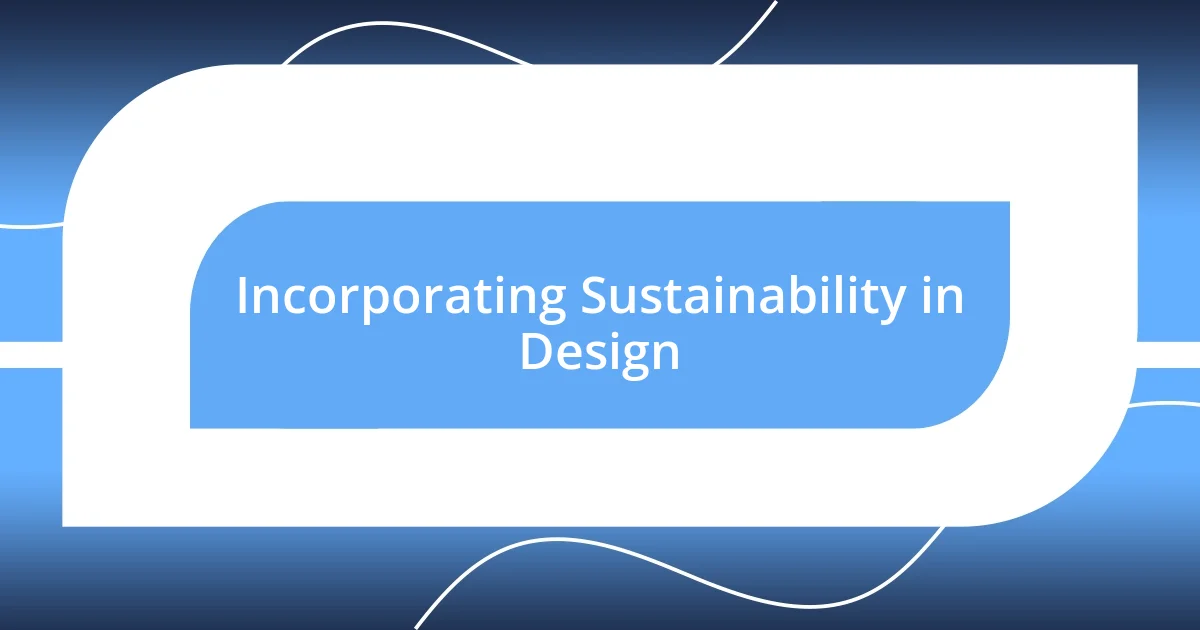Key takeaways:
- Contemporary design reflects social and cultural values, emphasizing sustainability and emotional connection to materials.
- Key elements for effective design include functionality, balance, color theory, and personalization, which collectively enhance both aesthetic appeal and practicality.
- Utilizing modern tools like digital design software and mood boards can streamline the design process and foster creativity, while thoughtful design choices profoundly impact daily experiences.

Understanding Contemporary Design Trends
Contemporary design trends are like a canvas painted by the collective vibes of our time, reflecting not just aesthetic preferences but also social and cultural values. When I think about how minimalism swept across homes a few years back, it resonates with my personal journey toward decluttering my life. Isn’t it fascinating how a simple, clean space can bring clarity and peace to our busy minds?
One thing I’ve noticed is the rising importance of sustainability in design. Nowadays, I find myself drawn to pieces that don’t just look good but also tell a story about their origins and impact on the planet. Have you ever picked up a chair made from reclaimed wood and felt a surge of connection to nature? That emotional response is a powerful testament to how contemporary design engages with our deeper values.
The integration of technology into everyday design is another trend that excites me. Smart homes filled with devices that enhance our lives seem to bridge the gap between tech and style. For example, when I installed a smart thermostat, I was thrilled not just by the ease of controlling my home’s temperature but also by how sleek and unobtrusive it looked on my wall. Isn’t it incredible how design is evolving to not only meet our needs but also enhance our emotional well-being?

Key Elements of Effective Design
Effective design is anchored in several key elements that enhance both function and aesthetic appeal. For me, one foundational aspect is balance; it creates harmony in a space. When I arranged my living room, I made sure to distribute visual weight evenly among furniture and decor, which transformed the room into a welcoming retreat rather than a chaotic zone. Achieving balance can be as simple as pairing a large sofa with lighter accent chairs.
Here are some elements that I believe are crucial for effective design:
- Functionality: Every piece should serve a purpose while looking good.
- Harmony and Balance: Achieving a seamless connection between all elements.
- Scale and Proportion: Ensuring items fit well within the space and relate harmoniously.
- Color Palette: Choosing a cohesive color scheme invites warmth and unity.
- Texture and Materials: Mixing textures creates depth and interest in design.
- Personalization: Infusing spaces with personal touches that reflect your identity and story.
As I reflect on my home office, it’s clear how pattern plays its part, too. A mix of stripes on my rug and a floral motif on the curtains adds layers of personality, making the space not just functional but also inspiring. When I enter that room, I feel a burst of creativity, showcasing how thoughtful design choices can elevate our everyday experiences.

Color Theory in Modern Design
Color plays a pivotal role in modern design, influencing moods and perceptions. From my experience, I’ve found that warm tones like reds and oranges can evoke energetic feelings, while cooler shades, such as blues and greens, bring a sense of tranquility. When I painted my office walls a calming blue, I noticed immediately how it helped reduce my stress levels during long work sessions. Isn’t it amazing how something as simple as choosing a color can impact our emotional well-being?
Understanding the associations we have with colors is crucial in contemporary design. For instance, I’ve learned that yellow often symbolizes happiness, but too much of it can overstimulate. During a recent home project, I opted for a soft, muted yellow in my kitchen, which created a bright, warm space without overwhelming my senses. It’s like weaving a narrative through color, and I truly believe that thoughtful color selection can transform the feel of a room entirely.
Moreover, the use of color contrast in modern design is a strategy that really strikes a chord with me. Playing with contrasts not only highlights key elements but also creates visual interest. While designing my living room, contrasting the deep navy of my sofa with vibrant coral cushions made the space come alive. I still remember the moment I stepped back and admired the energetic vibe; it felt like a breath of fresh air. How do you approach color contrast in your projects?
| Color | Association |
|---|---|
| Red | Energy, Passion |
| Blue | Tranquility, Calmness |
| Yellow | Happiness, Optimism |
| Green | Nature, Balance |
| Navy | Stability, Sophistication |
| Coral | Vibrancy, Youthfulness |

Incorporating Sustainability in Design
Sustainability in design resonates deeply with me, as I see it as an essential responsibility we all share. I remember when I decided to renovate my kitchen; I chose reclaimed wood for the cabinets. Not only did it lend an organic feel to the space, but I also felt a sense of pride knowing that I was reducing waste by giving new life to materials that would have otherwise been discarded. How fulfilling is it to create beauty while being kind to our planet?
I also noticed a shift in energy when I started incorporating plants into my decor. My living room blossomed with lush greenery, which not only enhanced the ambiance but also the air quality. It’s curious how a simple fern or a snake plant can instantly uplift a space and our mood. I’ve come to believe that greenery is not just an accessory but a vital part of a sustainable design approach.
Creating multi-functional spaces is another way I practice sustainability. By redesigning my home office to double as a guest room, I’ve reduced the need for additional furniture. It’s fascinating how a single room can serve various purposes while minimizing my ecological footprint. Have you explored how flexible designs can transform your living spaces?

Balancing Function and Aesthetics
Balancing function and aesthetics in design is a dance that I find both challenging and exhilarating. When I was designing my home office, I struggled with the layout. I wanted a space that was not only beautiful but also conducive to productivity. Ultimately, I chose a sleek desk with built-in shelving, allowing me to keep my workspace tidy while also showcasing my favorite books and art. This mix of practicality and visual appeal transformed my office into a haven, proving that thoughtful design decisions can elevate everyday experiences.
I’ve noticed that the materials we select also play a significant role in this balance. For instance, opting for a stylish upholstered chair that’s as comfortable as it is elegant can make long work hours feel less daunting. I still cherish the velvet chair I chose for my reading nook; it’s inviting and chic, and I love sinking into it after a long day. It begs the question: How can we prioritize comfort while honoring our personal style in our design choices?
Furthermore, lighting is an element that continuously astonishes me in its effect on both function and aesthetics. I used to rely on harsh overhead lights, but switching to warm-toned bulbs with stylish fixtures completely shifted the atmosphere of my living spaces. The soft glow creates a cozy vibe that enhances my decor while also providing adequate lighting for activities like reading or working on projects. Isn’t it fascinating how the right lighting can simultaneously uplift the look and functionality of a room?

Tools for Streamlined Design Process
In my experience, the right tools can make all the difference in streamlining the design process. For instance, I recently started using digital design software, which allows me to visualize my ideas in real-time. I remember the thrill when I created a 3D model of my living room, instantly seeing how different colors and layouts would come together—what a game-changer that was!
Project management tools have also transformed how I approach my design projects. Keeping track of deadlines and collaborating with contractors used to feel overwhelming, but now, I rely on apps that organize everything in one place. This shift not only eased my anxiety but also fostered clearer communication—who knew that simple organization could spark such joy?
Lastly, I can’t overstate the importance of mood boards in my creative process. Putting together a visual collage of colors, textures, and inspiration evokes a rush of excitement. When I worked on my bedroom redesign, assembling my mood board helped solidify my vision and guided my choices consistently. Isn’t it incredible how a collection of images can illuminate the path to a cohesive design?

Case Studies of Successful Designs
One of my favorite case studies involves a local café I frequented during the pandemic. The owner transformed a cramped space into an inviting sanctuary using clever design choices. They incorporated large windows for natural light and used greenery as both decor and air purification. I often found myself wondering how such small changes could create a sense of escape in a bustling urban environment—proof that thoughtful details can significantly enhance the overall experience.
Another compelling example comes from a friend who redesigned her small apartment kitchen. Initially, it was a drab area with outdated appliances, but after a complete overhaul, it turned into a bright, functional space that felt much larger. She installed open shelving that showcased her beautiful dishware and added a pop of color with a backsplash that reflected her personality. Reflecting on her journey, I realized how deeply our environments can affect our daily lives and inspire creativity in even the smallest spaces.
Lastly, I’ll always remember a workshop I attended about eco-friendly design. The speaker shared a story about his home in a rural setting, where he used reclaimed wood and solar panels to achieve a sustainable aesthetic. It made me rethink my approach to materials; embracing sustainability can not only elevate a design’s appeal but also foster a deeper connection to our environment. How often do we pause to consider the impact of our design choices on this planet? That perspective can truly change everything.














